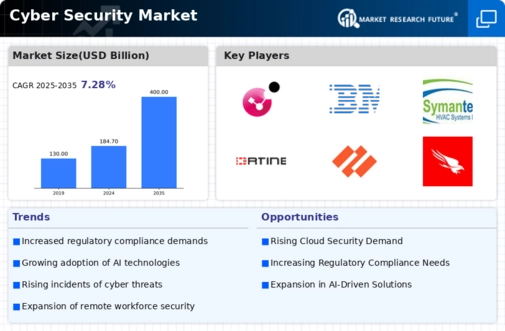Top Industry Leaders in the Global Cyber Security Market
Competitive Landscape of the Cyber Security Market
The world of cyber security is a rapidly evolving landscape, fueled by constant technological advancements and the ever-evolving tactics of malicious actors. In this dynamic market, understanding the competitive landscape is crucial for both established players and newcomers.
Key Players:
- Cisco Corporation
- Mcafee Corporation
- Fortinet Inc
- Trend Micro Inc.
- Cassidian Cyber Security Company
- Computer Science Corporation
- Booz Allen Hamilton Corporation
- Kaspersky Lab
- Fireeye Inc
- Symantec Corporation
Strategies for Success:
In this cutthroat environment, companies employ various strategies to gain an edge:
- Product Diversification: Expanding portfolios to cover multiple security segments, from network to endpoint to cloud.
- AI & Machine Learning Integration: Leveraging AI and ML algorithms for threat detection, incident response, and predictive analytics.
- Security-as-a-Service (SaaS): Offering subscription-based security solutions for increased flexibility and scalability.
- Strategic Partnerships: Collaborating with other vendors to offer comprehensive security solutions and reach new markets.
- M&A Activity: Acquisitions and mergers are common to acquire new technologies, talent, and market share.
Factors for Market Share Analysis:
Analyzing market share in the cyber security landscape requires looking beyond simple revenue figures. Some key factors include:
- Product Breadth & Depth: The range of security solutions offered and their effectiveness against evolving threats.
- Customer Base & Industry Focus: Penetration in different industries and geographic markets.
- Brand Reputation & Trust: The company's track record in protecting clients and its overall security expertise.
- Innovation & R&D Investment: Continuous development of new technologies and adaptation to new threat vectors.
- Pricing & Licensing Models: Attractiveness of pricing schemes and flexibility of deployment options.
Current Investment Trends:
The cyber security market is attracting significant investments, with key trends including:
- Focus on Cloud Security: Increased adoption of cloud computing necessitates robust cloud-based security solutions.
- Rise of Ransomware Defense: Growing ransomware attacks drive demand for specialized prevention and recovery tools.
- AI & ML Adoption: Integrating AI and ML into security platforms for automated threat detection and response.
- Security Automation & Orchestration: Automating security tasks to improve efficiency and reduce human error.
- Focus on Critical Infrastructure: Protecting critical infrastructure, including energy grids and healthcare systems, from cyber threats.
The cyber security market is a dynamic battleground with constant churn and innovation. Understanding the key players, their strategies, and the emerging trends is crucial for navigating this complex landscape. By analyzing market share factors and emerging companies, businesses can make informed decisions to stay ahead of the curve and protect themselves from ever-evolving threats.
This is just a brief overview of the competitive landscape of the cyber security market. Each segment warrants further exploration to gain deeper insights into specific technologies, players, and trends. The future of cyber security promises to be exciting, with continuous advancements pushing the boundaries of protection and defense against ever-more sophisticated threats.
Latest Company Updates:
Zero Trust Security on the Rise: Companies like Zscaler and Netskope are gaining traction with their least-privilege access approach, challenging traditional network security models.
Ransomware Defense Heats Up: Crowdstrike Falcon Overwatch and Palo Alto Networks Cortex XDR offer specialized tools for combating the growing ransomware threat, influencing market share in endpoint security.
Automation Taking Hold: Security Automation and Orchestration Platform (SOAR) providers like Demisto and Palo Alto Networks Cortex XSOAR are streamlining security operations, creating a new market segment with rapid growth potential.









